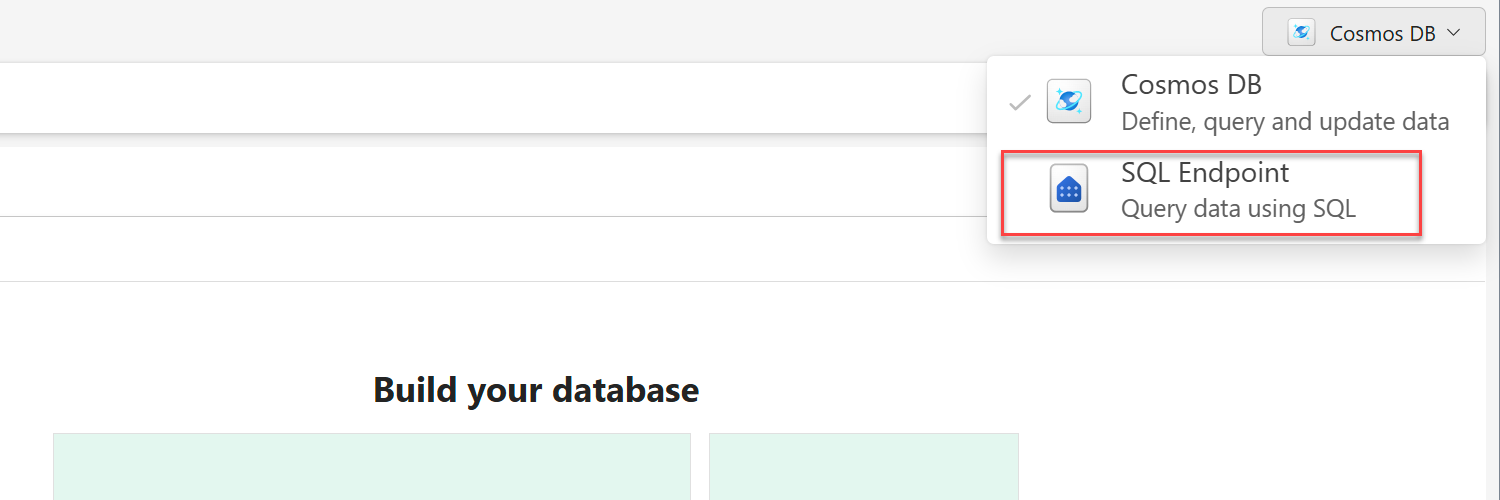Note
Access to this page requires authorization. You can try signing in or changing directories.
Access to this page requires authorization. You can try changing directories.
Important
This feature is in preview.
The mirrored SQL analytics endpoint makes it possible to create queries across two distinct Cosmos DB in Microsoft Fabric containers or databases. In this guide, you create a query that spans two Cosmos DB in Fabric databases.
Prerequisites
An existing Fabric capacity
- If you don't have Fabric capacity, start a Fabric trial.
An existing Cosmos DB database in Fabric
- If you don't have one already, create a new Cosmos DB database in Fabric.
An existing container with data
- If you don't have one already, we suggest that you load the sample data container.
- At least one other SQL analytics endpoint for a second Cosmos DB in Fabric database item.
Open the SQL analytics endpoint for the first database
Start by accessing the SQL analytics endpoint for the first Cosmos DB in Fabric database.
Open the Fabric portal (https://app.fabric.microsoft.com).
Navigate to your first Cosmos DB database.
Important
For this guide, the first Cosmos DB database has the sample data set already loaded. The remaining query examples in this guide assume that you're using the same data set for this database.
In the menu bar, select the Cosmos DB list and then select SQL Endpoint.
In the analytics endpoint page, select New SQL Query in the menu bar.
Open a new query editor and then run a test query. Ensure that you see the expected data.
SELECT TOP 5 countryOfOrigin AS geography, COUNT(*) AS itemCount FROM [<first-database-name>].[SampleData] GROUP BY countryOfOrigin ORDER BY COUNT(*) DESCThis query results in:
geographyitemCountNigeria21Egypt20France18Japan18Argentina17Note
This query also uses data found in the sample data set in a container named
SampleData. For more information, see sample data set.
Connect to the second database endpoint
Now, connect to the mirrored SQL analytics endpoint for a second Cosmos DB in Fabric database.
While still in the analytics endpoint page, select + Warehouses from the menu bar.
Add another SQL analytics endpoint item for the second Fabric item you want to query.
Open another new query editor and then run a test query. Again, ensure that you see the expected data.
SELECT * FROM [<second-database-endpoint>].[<second-database-name>].[<second-database-container-name>]Note
This example uses an arbitrary data set stored in the Cosmos DB in Fabric container. This data set contains region locales that correspond with the regions specified in the first query. A subset of this data set is available here:
namecodeNigeriaen-ngEgyptar-egFrancefr-frJapanja-jpArgentinaes-ar
Run a cross-database query
Finally, run a query that combines data from both databases.
While still within the SQL analytics endpoint, open a third query editor.
Run a query that combines data from both endpoints.
SELECT TOP 5 regionCodes.code AS regionCode, COUNT(*) AS itemCount FROM [<first-database-endpoint>].[<first-database-name>].[SampleData] sampleData INNER JOIN [<second-database-endpoint>].[<second-database-name>].[<second-database-container-name>] regionCodes ON sampleData.countryOfOrigin = regionCodes.name GROUP BY sampleData.countryOfOrigin, regionCodes.code ORDER BY itemCount DESCThis query results in:
regionCodeitemCounten-ng21ar-eg20fr-fr18ja-jp18es-ar17
